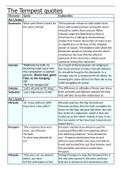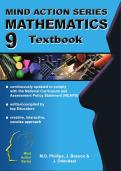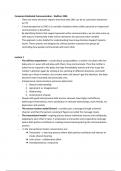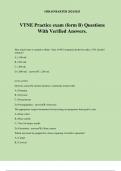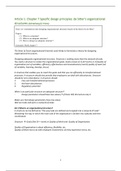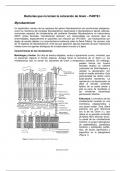Lecture 4 (BOOK) – Proteins:
structure and function
(Thunnissen)
Chapter 3: page 109-140, not 124-126 and 128-133
CH3 Proteins
The shape and structure of proteins
There are 20 different amino acids bwhich make up a protein molecule. The amino acids are linked to
its neighbours through a covalent peptide bond, proteins are therefore known as polypeptides.
The repeating sequence of atoms along the core of the polypeptide chain is referred to as the
polypeptide backbone. Attached to this are side chains which gave each amino acid its unique
properties.
The folding of a protein is determined by non-covalent bonds formed between the chain and/or side
chains. There are three types of these weak bonds which have all been mentioned before: hydrogen
bonds, electrostatic bonds and van der Waals attractions. Although these bondings may be weak,
the combined forces of large numbers of non-covalent bonds determines the stability of each folded
shape.
Hydrophobic clustering force is a fourth weak force which also has a central role in determining the
shape of a protein. Hydrophobic molecules tend to be forced together in aqueous environments in
order to minimise their disruptive effect on the hydrogen-bonded network of water molecules.
Conformation of lowest energy
, Most proteins have a particular three-dimensional structure which is determined by the order of the
amino acids in its chain. The final folded structure called the conformation is generally the one that
minimises its free energy.
Denaturing is the unfolding of a protein, and renaturing is the refolding of a protein.
Although a protein chain can fold itself without help, proteins called molecular chaperones often
assist in protein folding.
Large proteins usually consist of several protein domains which are structural units that fold more or
the less independently of each other.
The alpha helix and beta sheet
There are two regular folding patterns found called the alfa helix and the beta sheet. Both patterns
result from hydrogen bonding between N-H and C=O groups in the polypeptide backbone, without
involving the side chains.
A beta sheet occurs when two backbones run in the same orientation (parallel chains) and an alpha
helix is generated when a single polypeptide chain twists around on itself to form a rigid cilinder.
Alpha helices can wrap around eachother to form a stable structure called a coiled-coil. This can form
when the a helices have most of their non polar (hydrophobic) side chains on one side so they can
twist around each other with these side chains facing inward.
Four levels of organisation
Scientists distinguish four levels of organisation in the structure of a protein.
The primary structure is the amino acid sequence. Stretches of polypeptide
chain that form alpha helices or beta sheets constitute the protein’s
secondary structure. The full three-dimensional organisation of a
polypeptide chain is referred to as the tertiary structure. If a particular
protein molecule is formed as a complex of more than one polypeptide
chain, the complete structure is said to be the quaternary structure.
The protein domain is a substructure produced by any contiguous part of a
polypeptide chain that can fold independently of the rest of the protein into
a compact, stable structure. The different domains of a protein are often
associated with different functions.
Protein families
structure and function
(Thunnissen)
Chapter 3: page 109-140, not 124-126 and 128-133
CH3 Proteins
The shape and structure of proteins
There are 20 different amino acids bwhich make up a protein molecule. The amino acids are linked to
its neighbours through a covalent peptide bond, proteins are therefore known as polypeptides.
The repeating sequence of atoms along the core of the polypeptide chain is referred to as the
polypeptide backbone. Attached to this are side chains which gave each amino acid its unique
properties.
The folding of a protein is determined by non-covalent bonds formed between the chain and/or side
chains. There are three types of these weak bonds which have all been mentioned before: hydrogen
bonds, electrostatic bonds and van der Waals attractions. Although these bondings may be weak,
the combined forces of large numbers of non-covalent bonds determines the stability of each folded
shape.
Hydrophobic clustering force is a fourth weak force which also has a central role in determining the
shape of a protein. Hydrophobic molecules tend to be forced together in aqueous environments in
order to minimise their disruptive effect on the hydrogen-bonded network of water molecules.
Conformation of lowest energy
, Most proteins have a particular three-dimensional structure which is determined by the order of the
amino acids in its chain. The final folded structure called the conformation is generally the one that
minimises its free energy.
Denaturing is the unfolding of a protein, and renaturing is the refolding of a protein.
Although a protein chain can fold itself without help, proteins called molecular chaperones often
assist in protein folding.
Large proteins usually consist of several protein domains which are structural units that fold more or
the less independently of each other.
The alpha helix and beta sheet
There are two regular folding patterns found called the alfa helix and the beta sheet. Both patterns
result from hydrogen bonding between N-H and C=O groups in the polypeptide backbone, without
involving the side chains.
A beta sheet occurs when two backbones run in the same orientation (parallel chains) and an alpha
helix is generated when a single polypeptide chain twists around on itself to form a rigid cilinder.
Alpha helices can wrap around eachother to form a stable structure called a coiled-coil. This can form
when the a helices have most of their non polar (hydrophobic) side chains on one side so they can
twist around each other with these side chains facing inward.
Four levels of organisation
Scientists distinguish four levels of organisation in the structure of a protein.
The primary structure is the amino acid sequence. Stretches of polypeptide
chain that form alpha helices or beta sheets constitute the protein’s
secondary structure. The full three-dimensional organisation of a
polypeptide chain is referred to as the tertiary structure. If a particular
protein molecule is formed as a complex of more than one polypeptide
chain, the complete structure is said to be the quaternary structure.
The protein domain is a substructure produced by any contiguous part of a
polypeptide chain that can fold independently of the rest of the protein into
a compact, stable structure. The different domains of a protein are often
associated with different functions.
Protein families



